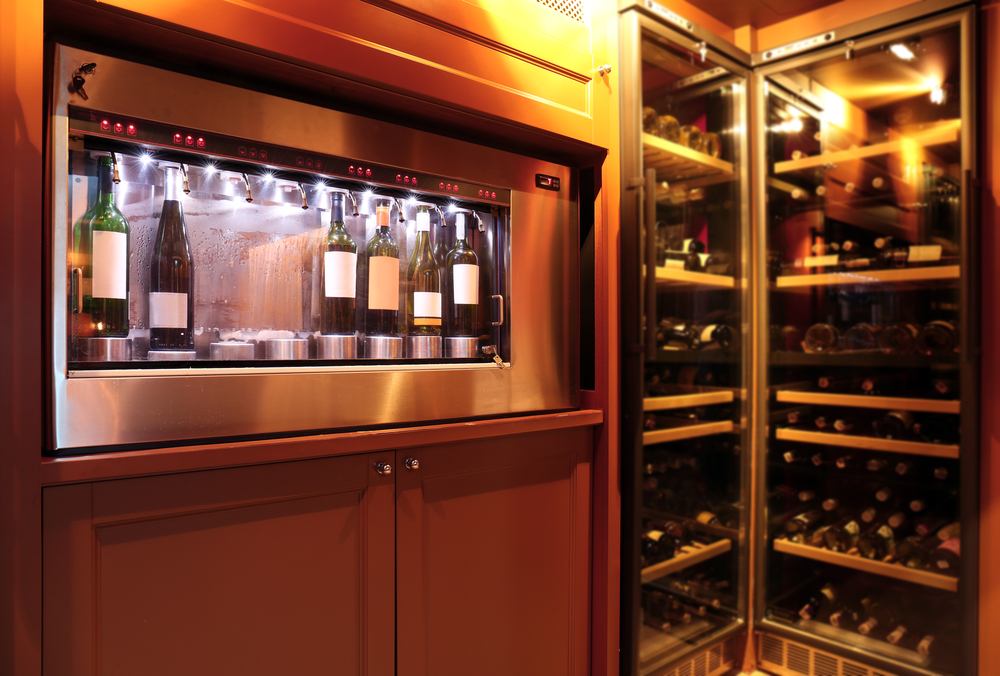Preserving the integrity and flavor of a wine collection begins with mastering the art of proper storage. By following expert guidance and incorporating thoughtful storage solutions, wine enthusiasts can ensure their bottles are stored in optimal conditions. Custom wine cellars, custom wine racks, and custom cabinetry take wine storage to a new level of sophistication. Below, we explore essential wine storage tips, along with expert insights from Lancaster Customs, to enhance your understanding of this art form. (Source: MasterClass, How to Store Wine at Home: 7 Tips, Written by MasterClass, Last updated: Aug 3, 2021, https://www.masterclass.com/articles/how-to-properly-store-wine-at-home).
Store Wine at the Proper Temperature
Wine thrives in a temperature range of 45°F to 65°F, with consistency being key. Fluctuating temperatures can lead to premature aging or spoilage.
“When planning for wine storage, it’s important to consider that even minor temperature shifts can affect the molecular structure of the wine. Precision in maintaining a consistent climate is the foundation of proper storage. One way to do this is by providing the appropriate custom cabinetry,” explains Lancaster Customs.
Store Wine Bottles Horizontally
Storing wine horizontally keeps the cork moist by maintaining contact with the liquid, preventing it from drying out and allowing oxygen to seep in.
“Horizontal storage isn’t just about practicality—it also enables efficient use of space while displaying the natural beauty of a wine collection. Thoughtful custom wine rack designs can enhance the organization and accessibility of the bottles, whether for long-term storage or regular enjoyment,” Lancaster Customs advises.
Protect Wine from Light and Vibration
Exposure to direct light and vibration can degrade wine over time, impacting its flavor and aroma.
“UV light accelerates the aging process by breaking down organic compounds in the wine. Meanwhile, vibrations disturb the sediment, which can lead to an imbalanced flavor profile. Combining proper shielding with stable storage ensures the integrity of the wine remains intact,” shares Lancaster Customs.
Store Wine at the Proper Humidity
Maintaining humidity levels is critical to keeping corks moist and preventing unwanted mold.
“Humidity control is often overlooked, but it plays a vital role in preserving the cork’s elasticity. Too little humidity dries it out, while excessive moisture creates an environment for mold growth. Achieving this balance is essential for long-term storage,” Lancaster Customs remarks.
Store Wine in a Proper Wine Fridge
Wine fridges are designed to provide stable, wine-friendly environments, unlike regular refrigerators, which are too cold and dry for wine storage.
“A wine fridge offers precision that traditional refrigerators lack. Consistent temperature and appropriate humidity levels are critical to avoiding the shrinkage of corks and the resulting oxygen exposure, which can damage the wine’s flavor,” notes Lancaster Customs.
Serve Wine at the Proper Temperature
Different wines should be served at specific temperatures—white wines between 45°F and 50°F and red wines between 60°F and 65°F.
“The serving temperature directly impacts how the flavors and aromas are perceived. A wine served too cold may mute its complexity, while overly warm wine can taste unbalanced. Calibrating storage and serving conditions ensures the full sensory experience of the wine is realized,” comments Lancaster Customs.
Store Open Bottles of Wine Properly
Opened bottles should be stored upright and sealed to minimize oxygen exposure, with some lasting up to a week, depending on the type of wine.
“When it comes to storing open bottles, minimizing air contact is key to preserving the wine’s freshness. Specialty compartments or vacuum-sealed stoppers can extend the life of the wine, allowing enthusiasts to enjoy every drop without compromising quality,” Lancaster Customs explains.
Mastering wine storage requires attention to detail and a commitment to maintaining the ideal environment for your collection. By implementing proper storage techniques and investing in personalized solutions such as custom wine cellars, racks, and cabinetry, wine enthusiasts can safeguard their investments and enhance the enjoyment of their wines.
“Wine storage isn’t just about preservation—it’s about elevating the entire experience. When done thoughtfully, the storage environment becomes as much a part of the collection as the bottles themselves, reflecting both functionality and the owner’s personal style,” Lancaster Customs concludes.
With expert knowledge and intentional design, wine collectors can store their bottles with care and confidence, ensuring their wines are ready to be enjoyed at their best.
